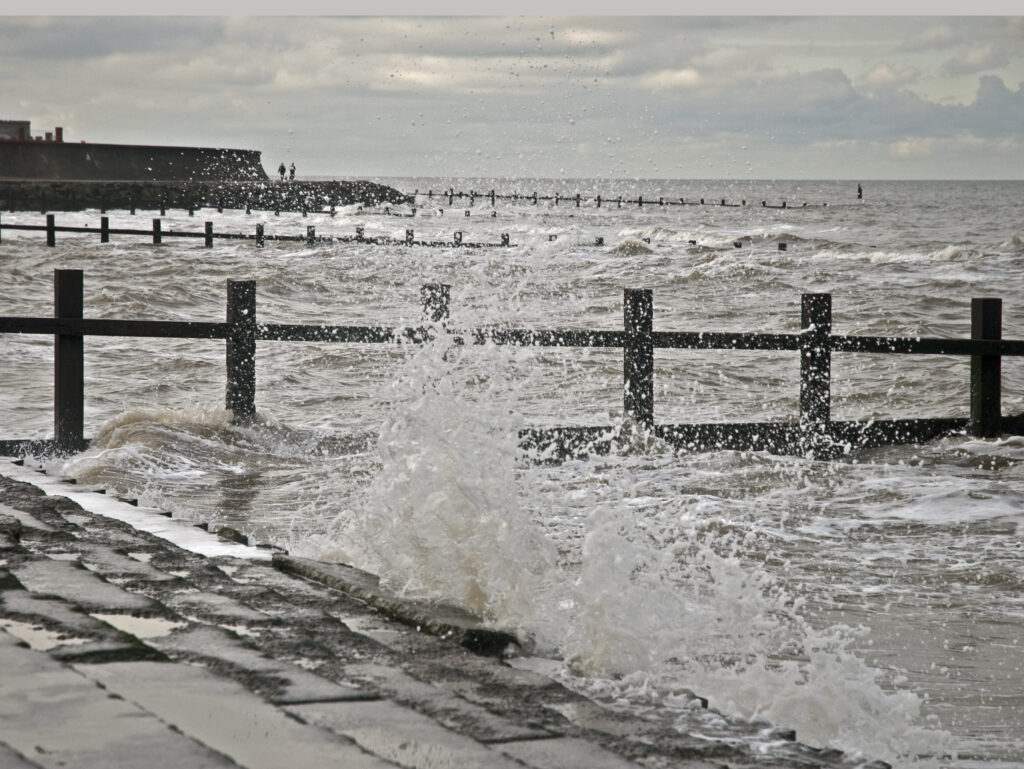Beth McAulay investigates the reasons behind the stalling of Rhyl’s Queens Market redevelopment.
My recollections of Rhyl’s Queens Market are not wholly tangible, or substantiated. My memory is a sensory one, mixed with unease. The stagnating fusty odour of polyester and the legacy of cigarette smoke; the oppressively narrow passageways, itchy and tight like a second-hand woollen jumper. Splinters of pinched light exploding prismatically, emanating from the transparent plastic lights of children’s rides. Beyond these largely abstract impressions, there is little in the way of objective visual memory.
That is, except for the antique marionette machines, whose puppets would dangle and dance with mechanical yet languorous synchronicity. Their painted faces leered grotesquely at the infant me through the mildewed glass. As a result, I avoided the place throughout subsequent years: in that time, the Market gradually hollowed out of activity and economy. Throughout its decline, it struggled to retain an ever-diminishing number of stores and stalls, mostly stocking inexpensive miscellanea. The tumbling pulse of the amusement machines reverberated desperately into what became otherwise an ominous echoing abyss. The Market had, by then, long been an uncanny, bastardised relic of old Rhyl, and in 2020 it was finally closed down.
Amid this epidemic of high street closures, Rhyl has excruciatingly little to offer locals and visitors alike, with its more affluent inhabitants avoiding the centre to enjoy recreational facilities elsewhere.
The Queens Buildings, the conglomeration of buildings of which the Queens Market comprised one dominant part, were identified as a ‘key catalyst project’ in the regeneration of Rhyl by Denbighshire County Council. Their ‘Rhyl Vision’ scheme, which predominantly seeks to alleviate the destitution of the town centre, was born partly out of the consensus that Rhyl has ‘lost its identity’. Though as the caravan parks that fringe the town continue to prosper, increasingly providing everything the town once did as a dynamic seaside resort, what Rhyl’s centre has really lost is a significant allotment of its tourist industry. This, importantly to residents who would still attest to the existence of a Rhyl ‘identity’, is a rather different matter. For those who live within Rhyl, that essential character arguably persists – what has changed is the town’s reputation and touristic appeal.
Yet, amid this epidemic of high street closures, Rhyl has excruciatingly little to offer locals and visitors alike, with its more affluent inhabitants avoiding the centre to enjoy recreational facilities elsewhere. Wealth is siphoned out of the economy, adversely affecting the town’s poorest while worsening Rhyl’s notoriety. There seems to be a unanimous sense that the town not only needs rescuing from its disrepair but furthermore ought to – as DCC’s statement asserts – ‘bring back a wider range of customers with higher disposable incomes and greater spending power’.
If, upon initial inspection, I deemed the vision commendably though sensibly aspirational, the gulf between its promise and its results leaves me questioning it. This ‘vision’ of Rhyl seems fundamentally flawed in who it is primarily aiming to serve, by focusing on solutions that can only really be enjoyed by those who can pay for them. For many in Rhyl, these spaces are simply inaccessible. Is this kind of quasi-gentrification the only option?
Robust debate and agenda-setting research.
Support Wales’ leading independent think tank.
In the case of the new Queens Market, however, it remains inaccessible to almost everyone, irrespective of how much they’re willing to spend. The new structure waits on a lonely promenade plot, visible through the apertures in the construction fencing. Its steel architecture is weatherworn, and its windowed façade is striated with seagull defecations.
The protracted delays in the opening of the Market can be linked to a series of operational and managerial failures. DCC, despite previously announcing an operator for the site in 2023, still await the finalisation of an agreement after the earlier one ended due to incompatibilities between the council’s and the prospective operator’s aspirations for the site, which negated any sort of satisfying ‘collaborative vision’. Due to these mismanaged deliberations, an initially estimated £9m expenditure for the redevelopment has swelled up to £12.6m according to reports published in May – and the project is far from completed.
Again, ‘vision’ appears not only as the operative word but also the one that betrays the naivety of the project. It is a vision that is shortsighted, and myopic. Following a cycle of hubristic schemes to stimulate Rhyl’s economic infrastructure over the last decade (such as an infamously extortionate balloon airship stationed a few metres mid-air on the promenade – which was eventually deflated after quickly being deemed inoperational, to some residents’ jubilation), locals are naturally disillusioned. And so am I, as I appraise the ongoing advertisement for traders to enliven the empty galleries of the new Queens Market. The ad specifies the need for products of a certain standard to correlate with its ‘artisan’ model. The Market is situated less than half a mile away from the ward which, in the Welsh Index of Multiple Deprivation survey of 2019, represented the highest level of deprivation in a small area in the entirety of Wales. The plan’s aspirations seem incongruous, if not insensitive to the point of being alienating.
For this article, I speak to ‘James’, who requests to be anonymised, about the impediments local business owners have faced in attempting to secure a trading unit in the new Market. In addition to rental costs, vendors have been informed they would have to fund any additional fittings: from the obvious decorative furnishings to energy installations and, in some cases, even foundational catering fittings. For several prospective local traders, this was financially implausible, and thus deterred many from applying.
For much of its hundred-year existence, the old Market inspired various speculations, but none as prominent as that concerning Little Venice.
Throughout the forty minutes I’m on the phone with James, his voice flares in frustration, cresting and jolting with every new grievance. He believes that there has simply been a lack of transparency about the project’s intentions: initially posited as a community space, it now doesn’t seem so altruistic. Adding insult to injury, he considers the new structure a ‘disaster… a cowshed, a warehouse’ – a betrayal of the architectural and community significance the old Market possessed. Indeed, James insists that representatives of DCC gave assurances that vital elements of the historic structure would be salvaged and repurposed, but as of yet there is no available evidence of this. James, for one, is pessimistic. He believes most of the artefacts once left in the neglected expanses of the old Market have now been disposed of or sold.
I’m directed to some social media pages dedicated to memories of the old Queens Market, several of which have tens of thousands of followers. The most recent posts, mostly dated from 2021, amount to a plaintive gallery of the demolition works. Amongst earlier posts: sporadic references to the mythic Little Venice, a cryptic complex of subterranean canals beneath the old Market. This enlivens my memory. For much of its hundred-year existence, the old Market inspired various speculations, but none as prominent as that concerning Little Venice.
The myth of the Market’s canal system has been nourished for decades by a single photograph, and yet it permeates the collective imagination of the town. Many claim to have witnessed it, or even sensed its presence through the splintered wooden floorboards of the Market, lurking in the inscrutable darkness of the basement. Its appeal was so tremendous that James mentions, when the Market was threatened with demolition, it provoked ever-intensifying threats of protest amongst local communities who wished to salvage it. Consequently, a conciliatory tour of the buildings, already in the process of being methodically devoured by machinery, was arranged for select members of these affiliated groups.
One of the objectives of their exploration was to find out the truth about the folkloric canals. Footage uploaded online features the group, luridly dressed, as they follow their torches through a catacombic succession of rooms. A supplementary, conclusive video explains the actuality of Little Venice and minimises the myth. Whilst local imagination has cultivated an image of an elaborate watercourse, the real attraction proved more akin to an ornate gutter; an optical illusion. Certainly, no gondoliers.
I mention this to James. He claims that not everyone is willing to accept the evidence, however, as some remain insistent that the canal simply remains undiscovered. Furthermore, loyalty to the myth seems to coexist with a desire for the town’s broader redemption. James mentions that many believe that the rediscovery of Little Venice can ‘bring visitors back’, like a sort of ‘holy grail’, he says, that could resuscitate Rhyl entirely.
A town such as Rhyl, having descended into poverty and ill-repute following decades of vibrancy, can be expected to appeal to people’s nostalgic inclinations. But the Queens Market of twenty years ago – the one my generation will recall – was rotting. Its walls were grimed and fissured. Stalls were vacant, partitioned by chipboard, or filled with rubbish: sale signs, stacks and sheaves of newspaper, tinsel, in dust-veiled piles, abandoned. All it managed to instil in me was a primitive fear of marionettes.
Nevertheless, the old Queens Market clearly constitutes a considerable part of Rhyl’s social history, its architectural heritage, its ostensibly ‘lost’ identity. But, within the collective imagination, it appears to have receded into the subterranean waters of its own slippery, unsubstantiated mythology. Redevelopment efforts such as the ‘Rhyl Vision’ may be controversial because they threaten to sanitise a locality’s essential identity – or, whatever fragments of it remain conserved.
However, what Rhyl can presently hope for is an end to the stagnancy caused by a succession of white elephants such as the new Queens Market. It needs development that is truly sympathetic and directly serves the needs of those who live in the vicinity. It needs something that will enable its residents to abandon their sentimentalism and move past the last failed vestiges of old Rhyl.
All articles published on the welsh agenda are subject to IWA’s disclaimer. If you want to support our work tackling Wales’ key challenges, consider becoming a member.





